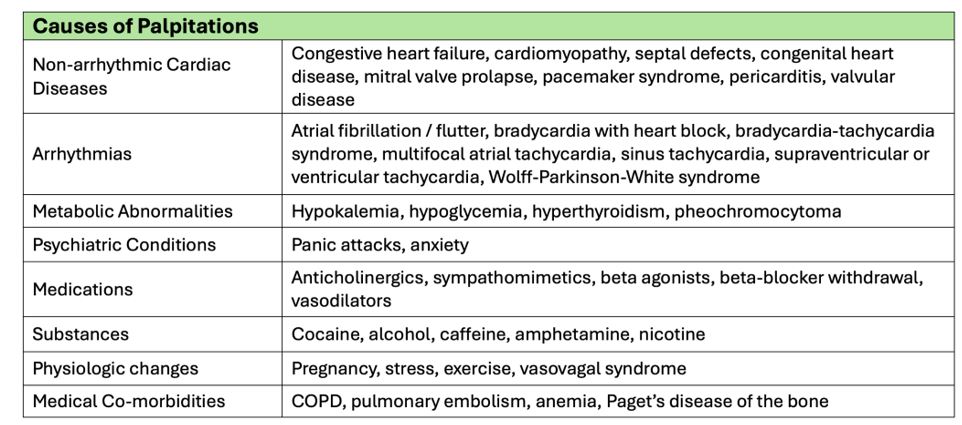Palpitation
Cardinal Presentations / Presenting Problems, Cardiovascular
First 5 Minutes
Life-threatening causes of palpitations:
- Arrhythmias (e.g., Wolff-Parkinson-White Syndrome, ventricular tachycardia, ventricular fibrillation, long QT syndrome – Torsades).
- Sepsis.
- Metabolic abnormalities.
- Structural or ischemic heart diseases.
Context
- 1/3rd of emergency department visits due to palpitations are estimated to be due to a cardiac cause.
- Palpitations are associated with a high admission rate to the hospital.
Diagnostic Process

Table 1. Differential Diagnosis for Palpitations
A 12-lead ECG should be obtained immediately for patients presenting with palpitations.
- Assess hemodynamic stability and address arrhythmia / underlying cause.
- For patients that don’t have diagnosis from ECG or cardiac exam, proceed to more comprehensive work-up.
ECG findings:
- Short PR interval & delta waves (supraventricular tachyarrhythmias, WPW syndrome).
- Pre-excitation syndromes (Lown-Ganong-Levine Syndrome or WPW syndrome).
- Deep Q waves in leads I, aVL, and V4, V5, V6 (left ventricular hypertrophy).
- QT prolongation and abnormal T waves (long QT syndrome).
- Polymorphic VT (Torsade de pointes).
- Bradycardias (heart blocks).
- Q waves characteristic of prior MI.
- Pseudo RBBB and persistent ST elevations in V1-V2 (Brugada syndrome).
Arrhythmogenic right ventricular dysplasia cardiomyopathy.
History:
- Inquire about: lightheadedness, syncope, and presence of pacemaker.
- Inquire about co-existing ischemic, structural, metabolic, drug induced, psychiatric, pregnancy, or related conditions.
- Family Hx of sudden death.
Physical Exam
- Cardiac exam.
- Signs of hyperthyroidism.
Lab work: anemia and metabolic abnormalities.
Consider urine drug screening for patients that are suspected of substance use.
If concerns for heart disease, consider referral to cardiology for an echocardiogram.
For unexplained palpitations, ambulatory ECG monitoring should be considered.
If palpitations are sustained or poorly tolerated, consider referral to cardiology.
Recommended Treatment
Specific treatment depends on the underlying cause of palpitations.
Some general treatments to consider include:
- Correction of metabolic imbalances (e.g., hypoglycemia, hypokalemia, hyperthyroidism).
- Discontinue offending medication or substance.
- Refer to psychiatry if underlying mental health condition suspected.
- For patients with palpitations that have an otherwise normal evaluation and normal sinus rhythm, consider holter monitor and to return during palpitations to evaluate.
- Manage arrhythmia depending on specific type (see in-depth resources).
Quality Of Evidence?

High
We are highly confident that the true effect lies close to that of the estimate of the effect. There is a wide range of studies included in the analyses with no major limitations, there is little variation between studies, and the summary estimate has a narrow confidence interval.
Moderate
We consider that the true effect is likely to be close to the estimate of the effect, but there is a possibility that it is substantially different. There are only a few studies and some have limitations but not major flaws, there are some variations between studies, or the confidence interval of the summary estimate is wide.
Low
When the true effect may be substantially different from the estimate of the effect. The studies have major flaws, there is important variations between studies, of the confidence interval of the summary estimate is very wide.
Justification
Diagnosis of palpitations and underlying causes.
Approach to life-threatening palpitations.
Related Information
OTHER RELEVANT INFORMATION
Reference List
Abbott AV. Diagnostic Approach to Palpitations. American Family Physician. 2005 Feb 15;71(4):743–50.
Wexler RK, Pleister A, Raman SV. Palpitations: Evaluation in the Primary Care Setting. American Family Physician. 2017 Dec 15;96(12):784–9.
Govender I, Nashed KK, Rangiah S, Okeke S, Maphasha OM. Palpitations: Evaluation and management by Primary Care Practitioners. South African Family Practice. 2022 Feb 24;64(1). doi:10.4102/safp.v64i1.5449
Zimetbaum PJ. Evaluation of palpitations in adults [Internet]. 2024 [cited 2024 Apr 16]. Available from: https://www.uptodate.com/contents/evaluation-of-palpitations-in-adults?search=palpitations&source=search_result&selectedTitle=1~150&usage_type=default&display_rank=1#H4272713002
Probst MA, Mower WR, Kanzaria HK, Hoffman JR, Buch EF, Sun BC. Analysis of emergency department visits for palpitations (from the National Hospital Ambulatory Medical Care Survey). The American Journal of Cardiology. 2014 May 15;113(10):1685–90. doi:10.1016/j.amjcard.2014.02.020
RESOURCE AUTHOR(S)

DISCLAIMER
The purpose of this document is to provide health care professionals with key facts and recommendations for the diagnosis and treatment of patients in the emergency department. This summary was produced by Emergency Care BC (formerly the BC Emergency Medicine Network) and uses the best available knowledge at the time of publication. However, healthcare professionals should continue to use their own judgment and take into consideration context, resources and other relevant factors. Emergency Care BC is not liable for any damages, claims, liabilities, costs or obligations arising from the use of this document including loss or damages arising from any claims made by a third party. Emergency Care BC also assumes no responsibility or liability for changes made to this document without its consent.
Last Updated Jun 02, 2024
Visit our website at https://emergencycarebc.ca
COMMENTS (0)
Add public comment…


POST COMMENT
We welcome your contribution! If you are a member, log in here. If not, you can still submit a comment but we just need some information.